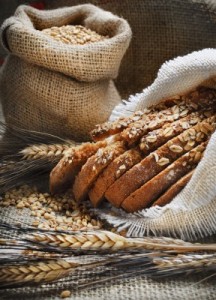In part 1 of this series we discussed oils, high fructose corn syrup and full fat vs fat-free products. Incorporating these small changes will produce big payoffs for you and your family. This next change is a little bigger but so important. Yes, we are going to discuss wheat.
Since wheat is such a huge topic to cover, we are going to break it down into part a and part b.
- Gas
- Bloating

- Acid Reflux
- IBS
- Chronic sinus infections
- Chronic cough
- Psoriasis
- Acne
- Hair loss
- Foggy brain
- Headaches
- Joint pain
- High blood sugar
Could all of these issues really improve with the elimination of wheat? Say it isn’t so!
A couple of years ago when I started incorporating a primal/paleo diet into my life I was still eating wheat 1-2 times per week. It wasn’t until I cut down to this frequency that I was able to pinpoint the effects of it on my body. Within a few hours I would have severe heartburn. I could take pepcid and get some relief but the heartburn would not completely subside for 2-3 days. Within 12 hours extreme lethargy and fatigue would set in. It was like I had been hit by a truck! Plus my brain would get foggy and I would also get a headache. It was then that I decided to give it up for good. How many people take antacids on a daily basis? Could the simple act of removing wheat “cure” them? Why does wheat produce these effects on the body? And how come our grandparents didn’t have these issues?
To really understand what’s going on, a look at the history of wheat is in order. The wheat of today is not the wheat of our parents and grandparents. Dr. William Davis, author of the book Wheat Belly has extensively researched the history of wheat and exactly where (and when) things went wrong.
During the 1960’s and 1970’s wheat underwent an extensive genetic transformation with the original intent being increased yield. Scientists and geneticists were successful in this accomplishment. As Dr. Davis says
“From the perspective of Third world countries, for instance, that adopted high-yield wheat strains in the 1970’s, famine was converted to surplus within a year of their introduction. High yield strains of wheat became cause for celebration.”
He goes on to say
“Modern high-yield, semi-dwarf wheat is not the result of a few hybridizations, but the result of thousands of hybridization events conducted by geneticists, repeated breeding to select for qualities like height and seed size, resulting in the creation of many unique proteins and other compounds. And breeding efforts ventured much further than just crossing two plants, often employing techniques we’d consider extreme or bizarre. It means hundreds of unique compounds to consuming humans never before encountered in nature. Problem: Geneticists assumed that, regardless of the degree of genetic changes introduced into the plan, no matter how severe the change in appearance, no matter how bizarre some of the methods used to generate those changes, it remains suitable for human consumption.
So we are all concerned about genetically modified food – lobbying congress, submitting petitions, vowing that they must all be labeled. But we are missing the biggest offender! The biggest frankenfood of them all! A food that does not even resemble it’s predecessor! A food that was never tested on humans to deem it safe! Shouldn’t we be outraged?
So, what’s so bad about the “new” wheat? Let’s start with the first offender – gliadin.
Gliadin is a protein found in the gluten family of proteins. Although gluten gets all the attention, according to Dr. Davis gliadin is the culprit behind many health issues. It has hundreds of variations and is capable of increasing intestinal “leakiness”. In addition, the new forms of wheat gliadin have been shown to have the same effects on the brain as opiates (like heroin). “The opiate-like effects of wheat gliadin are that of increased appetite and increased calorie consumption, with studies demonstrating a very consistent increased calorie intake of 400 or more calories per day.” Wow! Basically, eating wheat makes you addicted to wheat!
That’s it for part 2a of this discussion. I hope I have raised a lot of questions in your mind as to the consumption of wheat by you and your family. In part 2b we’ll learn about gluten, lectins and other negative characteristics of the biggest frankenfood of them all – WHEAT.